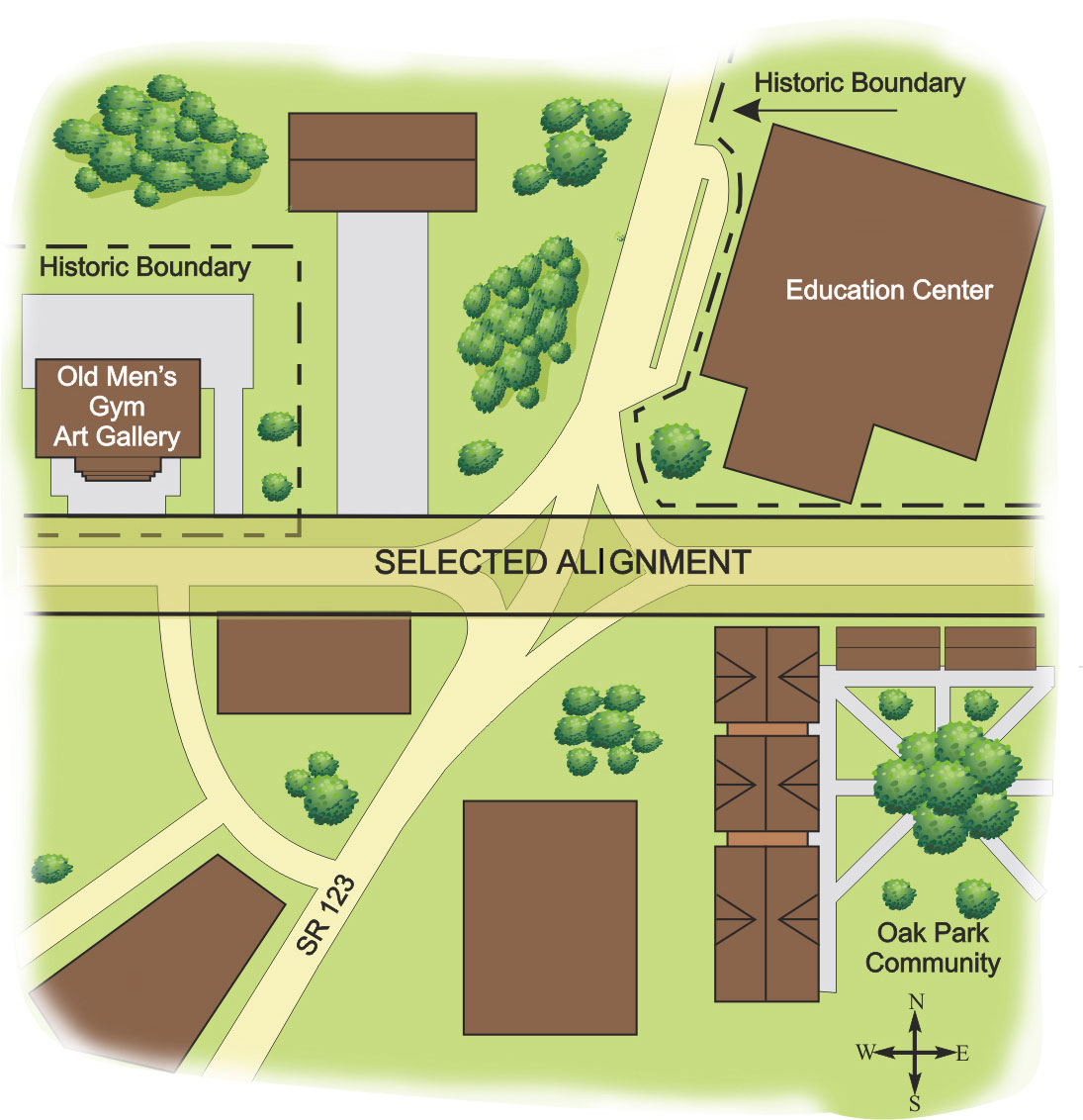Project Examples
Creative Mitigation for a Section 4(f) Use Example
This case study highlights the creative mitigation measures developed for a project on State Route 123 (SR 123) which involved the use of a privately-owned historic Section 4(f) property. These measures were developed in consultation with the State Historic Preservation Officer (SHPO) who is the official with jurisdiction for historic Section 4(f) properties, other consulting parties, and the public.
Overview/Purpose and Need
A project is proposed is to improve traffic operations and safety conditions along State Route (SR) 123. The State DOT proposes to widen the highway from two to three lanes, with auxiliary lanes along a portion of the highway.
The project area involves a portion of SR 123 that divides the campus of Ford College from the community of Oak Park. The campus sits to the east of the highway; Oak Park, to the west. The college has two buildings that are eligible for the National Register of Historic Places (NRHP) —the old Men's Gym Art Gallery (built in the 1950s are currently used as an arts space) and the Education Center (also known as the Old Main, which was the original administration office).
Challenges
The project team sought to identify an alternative that met the project purpose and need, while avoiding impacts to the campus historic buildings and the businesses of the Oak Park community. Several alternatives were considered, each with various impacts:
- Alternative 1 (No-Build Alternative): the no-build alternative was not considered prudent, because it did not meet the project’s purpose and need.
- Alternative 2 and 3 (Avoidance Alternatives): two avoidance alternatives were developed, but these alternatives were also not considered prudent because they did not meet the project’s purpose and need.
- Alternative 4: an alternative that avoided the two historic buildings was developed; however, it would require the displacement of 58 Oak Park businesses located on the west side of the roadway. This alternative would have removed most local retail businesses, including all the restaurants and bookstores that currently serve both the campus and the local neighborhood. Because this alternative would have removed most of the local commercial tax base as well as essential businesses to campus and community, it created truly unique problems and was not considered prudent.
- Alternative 5 and 6: Two alternatives were developed to limit or minimize impacts to the historic buildings and the Oak Park community. These two alternatives left the existing roadway cross section essentially unchanged. It was determined that Alternative 5 failed to improve the minimum level of service, while Alternative 6 did not adequately address traffic congestion during peak hours. Because these alternatives did not meet the project purpose, they were not considered prudent.
- Alternative 7: an additional alternative was developed that would limit impacts to the historic buildings and the Oak Park community, and meet the project purpose and need. However, there would still be a Section 4(f) use, as this alternative would require the removal of the old Men’s Gym.
Solution
The project team, including the State DOT sponsor and FHWA, determined that all alternatives, except for Alternative 7, would either fail to meet the project purpose and need or result in unique problems for the Oak Park community. As such, Alternative 7 was identified as the preferred alternative.

Since the preferred alternative would use Section 4(f) properties the project team was required to conduct all possible planning to minimize harm. The efforts taken to minimize harm to the Section 4(f) properties resulted in the avoidance of all impacts to the Education Center, but the old Men's Gym was still impacted. As a result, the project team pursued mitigation measures to compensate for the Section 4(f) impact that cannot be avoided.
Mitigation Measures - Standard mitigation for removal of historic buildings usually entails recording the structure in detailed plans and by photographs. Creative mitigation entails developing actions that recognize the special place a building has in the history and culture of a location. Such mitigation strives to preserve the stories, associations, and feelings tied to specific buildings and places, usually by involving the public through interpretation and display.
The State DOT began its mitigation planning with meetings with the SHPO. In addition, since Ford College and its students would be most directly affected by the project the project team also coordinated with College stakeholders (college staff, students, and the public) to develop mitigation measures. The project team was able to learn about the history and value stakeholders had for the old gym and to gather proposals for mitigation. Several suggestions were offered: 1) Save some of the windows and flooring from the old gym for reuse in either a new gym or another building, 2) create a three-dimensional exhibit panel describing the significance of the historic Men's Gym and include contemporary and historic photographs of the building, and 3) erect a marker at the site of the old Men's Gym that summarizes the history of the gym and its connection to the college.
The project team then took the suggestions and developed a mitigation proposal that included the project team, the SHPO, and Ford College. The project team agreed to photo document the old Men’s Gym today, erect a marker to interpret the place where the Men’s Gym was located, and to pay for an exhibit to be developed about the building. The college committed to storing a portion of the gym flooring and several windows for reuse in a new structure that would be new College Art Gallery and would allocate space for the exhibit. The SHPO committed to assist in developing the exhibit. All these commitments were recorded in a Memorandum of Agreement, signed by all the parties.
Outcome
Creative mitigation may require extra effort to engage the community and other stakeholders, but can result in actions that recognize the specific context of the loss of the Section 4(f) property.
